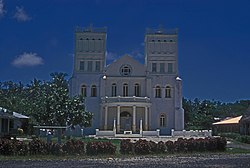Leone | |
|---|---|
Village | |
 Zion Church (Siona) | |
| Etymology: Samoan: le one ("no famine") | |
| Nickname: "Leone o le Tinā o le Alofa"[1] | |
| Coordinates: 14°20′38″S 170°47′06″W / 14.34389°S 170.78500°W | |
| Country | |
| Territory | |
| County | Lealataua |
| Area | |
• Total | 2.37 sq mi (6.13 km2) |
| Population (2020) | |
• Total | 1,598 |
| • Density | 680/sq mi (260/km2) |
| Time zone | Samoa Time Zone |
| ZIP code | 96799 |
| Area code | +1 684 |
Leone is the second-largest city on Tutuila Island's west coast.[2] The village is on the south-west coast of Tutuila Island, American Samoa. Leone was the ancient capital of Tutuila Island.[3][4][5][6] Leone was also where the Samoan Islands’ first missionary, John Williams, visited on October 18, 1832. A monument in honor of Williams has been erected in front of Zion Church. Its large church was the first to be built in American Samoa. It has three towers, a carved ceiling and stained glass. Until steamships were invented, Leone was the preferred anchorage of sailing ships which did not risk entering Pago Pago Harbor. Much early contact between Samoans and Europeans took place in Leone.[7][8]
The village is home to some of the oldest buildings on Tutuila Island.[2] Besides the oldest church in American Samoa, Leone is home to a post office, high school, Pritchard's Bakery, and Kruse Supermarket. Buses from Fagatogo to Leone leave every few minutes throughout the year.[4] An airstrip was built at Leone during World War II.[9] The village is home to two historical sites listed on the U.S. National Register of Historic Places: Fagalele Boys School, which may be the oldest building on Tutuila Island, and Tataga-Matau Fortified Quarry Complex.
Until the invention of the motorboat, Pago Pago Harbor was of little value as the ships were unable to turn around in such a confined area. The most common anchorage was therefore in Leone, where the first missionaries also arrived.[10] Its strategic location, directly over the southern horizon from Upolu Island, and the district Atua, has made Leone a major resting port for those traveling between Upolu, Tutuila, and the Manu'a Islands. Leone is now a lively municipal center. The origin of several of Leone's chiefly titles can be traced to Western Samoa.[11]
- ^ Fai’ivae, Alex Godinet (2018). Ole Manuō o Tala Tu’u Ma Fisaga o Tala Ave. Amerika Samoa Humanities Council. Page 154. ISBN 9781546229070.
- ^ a b Clayville, Melinda (2021). Explore American Samoa: The Complete Guide to Tutuila, Aunu'u, and Manu'a Islands. Page 70. ISBN 9798556052970.
- ^ Stanley, David (1999). South Pacific Handbook. Moon Handbooks. Page 445. ISBN 9781566911726.
- ^ a b Swaney, Deanna (1994). Samoa: Western & American Samoa: a Lonely Planet Travel Survival Kit. Lonely Planet Publications. Page 180. ISBN 9780864422255.
- ^ Brillat, Michael (1999). South Pacific Islands. Hunter Publishing, Inc. Page 139. ISBN 9783886181049.
- ^ Schyma, Rosemarie (2013). Südsee. DuMont Reiseverlag. Page 268. ISBN 9783770176946.
- ^ Stanley, David (1999). Moon Handbooks Tonga-Samoa. David Stanley. Page 177. ISBN 9781566911740.
- ^ "Leone | American Samoa Attractions".
- ^ Shaffer, Robert J. (2000). American Samoa: 100 Years Under the United States Flag. Island Heritage. Page 176. ISBN 9780896103399.
- ^ Swaney, Deanna (1994). Samoa: Western & American Samoa: a Lonely Planet Travel Survival Kit. Lonely Planet Publications. Page 164. ISBN 9780864422255.
- ^ Fai’ivae, Alex Godinet (2018). Ole Manuō o Tala Tu’u Ma Fisaga o Tala Ave. Amerika Samoa Humanities Council. Page 155. ISBN 9781546229070.
